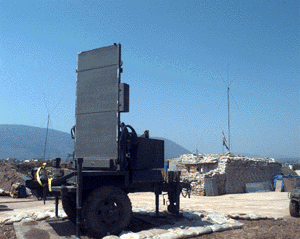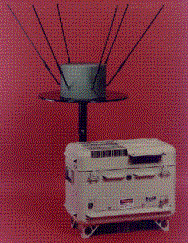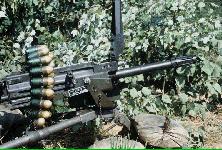Modern air forces have sophisticated jamming aircraft like the EA-6B Prowler to protect strike aircraft. These jammers are so successful that they are considered essential for all strike missions. However, armored forces have no countermeasure escorts. Although Iraqi tanks were easily destroyed by attack helicopters during the 1991Gulf war, tankers have not grasped the need for dedicated countermeasures vehicles. This has become more critical due to the development of artillery and aircraft delivered anti-armor guided munitions. These "top-attack" munitions use on infra-red, acoustic, or imaging sensors to destroy vehicles. All tank, mechanized, and motorized forces need vehicles which can jam these weapons.

Modify this "Linebacker" to function like the EA-6B airborne jammer
All the required technology for a jamming vehicle has been developed, but it was never integrated into a single unit. The ideal platforms are the existing anti-aircraft systems, like the M6 Bradley Linebacker for heavy forces, the LAV-AD for medium forces, and the HMMWV-Avenger for light forces. At least one of these "jammers" should exist in each company, or one per platoon for action against modern armies. Depending of the terrain, the jammer will closely follow attack elements to provide quick jamming support.
The first step is to add a counter-battery radar system to the turret, like the "Firefinder" (below). This will provide at least a one minute warning of incoming artillery, mortar, or missiles. Ideally, the radar could also provide warning of helicopter and aircraft launched missiles. The jammer radar system does not need to be as large and powerful as existing firefinder systems since it is only for local defense. This will provide three advantages for units not engaged in direct combat.
 1) an
early "incoming" warning will allow everyone time to seek cover or
button-up tanks.
1) an
early "incoming" warning will allow everyone time to seek cover or
button-up tanks.
2) the commander will know the origin of incoming fire and may return fire or attack in that direction.
3) vehicles can seek overhead cover if available, like large trees, or move close to buildings or similar obstructions and park. They can shut down engines to hide from acoustic missiles and reduce infra-red output, although the engine would still remain hot. They can pop smoke and toss out flares to fool munitions.
 The jammer should include a radar warning receiver and a laser warning
receiver to detect targeting. It should also include a version of the
"Shortstop" proximity fuse countermeasure system (right) which causes
artillery and mortar fuses to detonate prematurely. Since an enemy
may employ GPS guided munitions, GPS frequency jammers should be included.
The jammer should include a radar warning receiver and a laser warning
receiver to detect targeting. It should also include a version of the
"Shortstop" proximity fuse countermeasure system (right) which causes
artillery and mortar fuses to detonate prematurely. Since an enemy
may employ GPS guided munitions, GPS frequency jammers should be included.
The final change is to replace the automatic 25mm gun with a four MK-19 40mm grenade launchers (below). They could fire chaff, flare, smoke rounds, and anti-armor rounds (e.g. anti-helicopter). The rounds may come in mixed belts, or each launcher could fire a different type.
 The gun would need a high-elevation mount to provide overhead screening
fires. It may need a bleed system so the gunner can vent barrel pressure
to limit the distance which countermeasure rounds travel. The gunner would rely
on the radar to help aim rounds to explode between incoming rounds and their
targets. As attack helicopters and aircraft
guide their anti-tank missiles for a kill, they will suddenly be treated to a blinding fireworks show. By the time it clears their missiles have
missed, and anti-aircraft systems are ready to deal with the threat.
The gun would need a high-elevation mount to provide overhead screening
fires. It may need a bleed system so the gunner can vent barrel pressure
to limit the distance which countermeasure rounds travel. The gunner would rely
on the radar to help aim rounds to explode between incoming rounds and their
targets. As attack helicopters and aircraft
guide their anti-tank missiles for a kill, they will suddenly be treated to a blinding fireworks show. By the time it clears their missiles have
missed, and anti-aircraft systems are ready to deal with the threat.
The 40mm gun can also provide screening barrages during attacks to confuse ground launched missiles as well. With each gun capable or firing 350 rounds a minute, this jammer could provide an instant screen capable of confusing most guidance for incoming rounds and missiles. The gun could also lay down an impressive barrage to clear out entrenched infantrymen. Ground forces need the same jamming protection now enjoyed by attack aircraft; dedicated jamming vehicles are the answer.
Carlton Meyer editorG2mil@Gmail.com